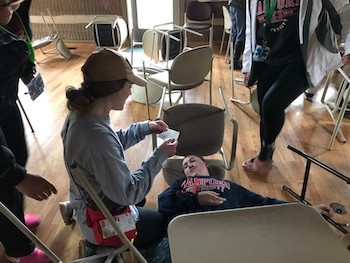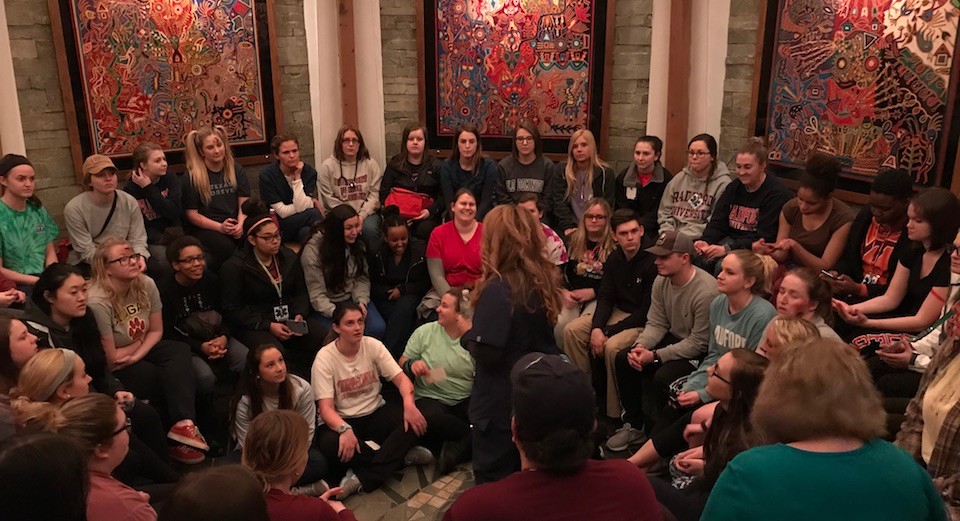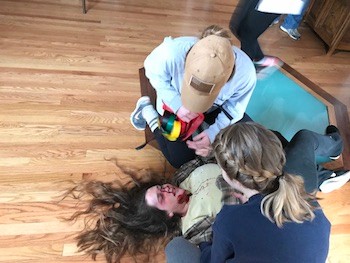Senior nursing students participate in mock disaster drill

More than 50 senior nursing students participated in a wide-ranging mock disaster drill at Selu Observatory and Conservancy on Feb. 28.
The students were divided into three groups in which they portrayed victims, emergency first responders and hospital nurses in the exercise that was completely run by students. The exercise is part of a Disaster Preparedness Workshop and Community Nursing course led by Dr. Erin Cruise and Professor Emeritus Maggie Bassett.
The workshop is a collaborative partnership with David Linkous, a Radford School of Nursing graduate and emergency planner from the New River Health District; Tammy Turpin, emergency management consultant for Carilion New River Valley Medical Center and Giles Hospital; and Grady DeVilbiss, director of the Office of Emergency Management at Radford University. Presenters hailed from various agencies responsible for managing emergency preparedness and disaster response across the region. The drill happens once a semester and has occurred the previous 12 years.
Cruise said that the drill is a response to natural and man-made disasters and ensures that Radford University’s nursing graduates are prepared to respond to modern day tragedies.
“In today’s world, nurses never know what they may be called upon to handle in their work,” Cruise said. “Nurses in hospital and community settings routinely deal with communicable disease outbreaks, such as flu or norovirus, weather emergencies, an escalating number of mass shooting incidents, bioterrorism concerns, the opioid crisis and methamphetamine production. Nurses need to be prepared to manage these disasters in a way that saves as many victims as possible while preventing the spread of disease or contamination to themselves, other health care workers and their communities.”

Tammy Turpin leads a debrief following the drill.
In the Feb. 28 event, nursing students responded to an explosion, an active shooter and multiple injuries. Among the injured were children and mentally ill patients, who increased the difficulty for the first responders.
Students, donning fake blood and injuries, were placed inside of a house at Selu Observatory and Conservancy. With the emergency response call placed, the drill was underway.
As the students portraying the first responders flooded into the house, they were met with the aftermath of a rock concert gone bad. Victims were strewn about. Responders had to practice identifying who they could help.
“We are assessing for the people who are able to walk so they can clear out of the scene,” said Mary Crowell, a senior nursing student from Radford. “We’re then looking for the people who aren’t able to walk but don’t have life threatening injuries. Lastly, we are looking for people with life threatening injuries. We triage that way and go about the scene.”
Afterwards, Crowell said, the emergency medical services (EMS) team would transport patients after conducting a rapid assessment of each patient.
Megan Berry from Chantilly said that portraying a victim was challenging, but everyone was able to see what goes on during a high-risk situation.

“All these patients are critically injured and the EMS has to figure out the best possible treatment,” she said. “It’s putting us on our toes and giving us real-life examples. When we start working, we’ll have patients from these scenarios coming to our hospitals. We need to be prepared to manage our time and resources.”
Berry portrayed a victim with life-threatening injuries and had a faint pulse. “Since I have a faint pulse and am dying, I’m not high on their priority list,” she said. “They can’t do much to save me because I’m so far gone. They will go to the other patients first before coming back to me.”
One of the students portraying a nurse, Samantha Spadavecchia, said that the patients “flooded” in quickly once EMS arrived at the hospital.
“One of the most valuable lessons wasn’t triaging people as they came in, but deciding who to have wait, who needed a second look and who needed to be seen immediately,” she said. “Having limited staff handle the challenging patients that came in demanded additional attention.”
School of Communication journalism students added another sense of realism – journalists trying to get information from nurses and gathering information from the scene.
“It was a really great learning experience for me in interacting with medical staff during a crisis,” said Abby Bailey, one of the journalism students. “Getting to speak with reporters from the Roanoke Times was incredibly insightful in how to approach people, phrase questions and respectfully report accurate information.”
Spadavecchia said the hospital relied on EMS’ initial descriptions of the patients in administering initial triage of people. A red tag means a patient is critically ill but may survive. A yellow tag is serious, but a higher potential for survival. A green tag means a patient has minimal injuries. A black tag means a patient is not expected to survive and a gray tag means the patient has passed away.
“We had a nurse there that was assigned to be with the green people to reevaluate them,” she said. “We had some people that moved from green to red initially. We were anticipating people having anxiety with symptoms on chest pain. Most went back to the green mark after further evaluation.
Remaining calm under pressure, along with re-evaluating and re-prioritizing, were skills Spadavecchia said she gained from the drill.
Turpin said that she was impressed with how the students handled the evolving and challenging situation.
“We teach all hazards, so it isn’t just exclusively one event,” Turpin said. “It’s everything. Through the drill we try to teach more about the influx of patients so you aren’t getting the one or two patients at a time – a handful are going in with critical injuries. The students are also learning how to process that and triage those patients.”